Bedroom Paint Color Ideas from Sherwin Williams

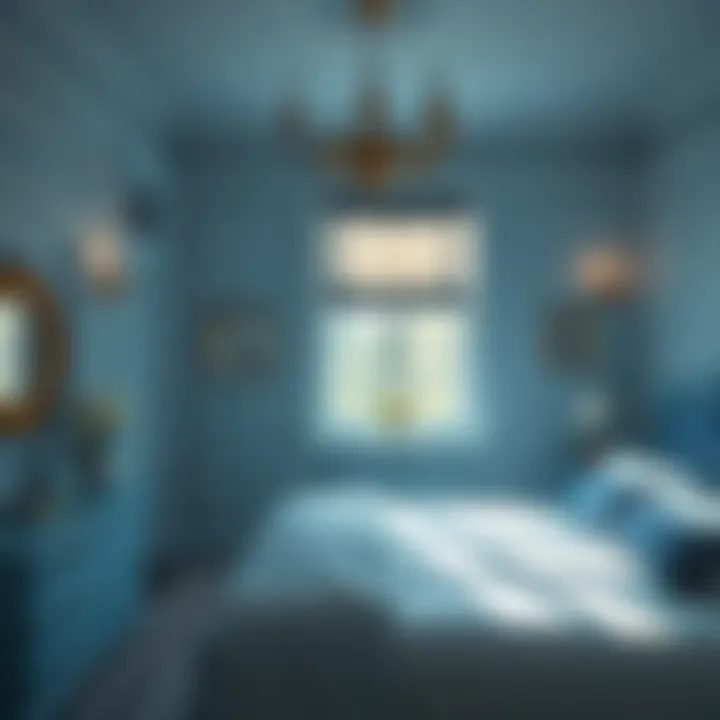
Intro
Choosing the right paint color for your bedroom is not just an aesthetic decision; it's also a deeply personal one. Colors can dramatically influence the mood and feel of a space, and with Sherwin Williams’ vast collection of paint options, homeowners have a world of choices at their fingertips. Whether you're after a serene retreat or a bold statement, understanding color psychology and current trends can guide your decisions.
The design landscape has evolved, embracing a mix of styles that cater to varied tastes. With an eye on both contemporary and timeless, Sherwin Williams offers a range of hues, from soft pastels to deep, warming shades. This guide aims to navigate through some of the most inspiring bedroom paint color ideas, ensuring your sanctuary reflects your unique style while promoting tranquility and comfort.
As we delve into design inspirations, trending styles, and favorite color palettes, remember that your bedroom is not just a place to sleep. It’s your personal haven, a reflection of who you are. Let’s explore how to transform it with the perfect colors.
Design Inspirations
Trending Styles
Today's trends in bedroom design are as diverse as the people who inhabit those spaces. Minimalism, for instance, continues to hold strong appeal, characterized by soft, muted colors that evoke calmness. Think pale grays, off-whites, and serene blues. They make a space feel open and airy, perfect for anyone looking to create a peaceful retreat.
On the flip side, the bohemian style invites a riot of colors. Rich reds and earthy browns, mixed with vibrant artwork, can turn a simple room into an eclectic masterpiece. The key here is to balance bold hues with natural textures for a harmonious feel.
*
"The color you choose speaks volumes about your personality and sets the tone of your space."
*
Color Palettes
Sherwin Williams boasts unique color palettes tailored for various themes. Consider the "Calm and Cozy" palette, which features tranquil shades of green and soft grays. These hues can create a soothing atmosphere, perfect after a long day. Alternatively, the "Rich and Bold" palette highlights jewel tones like emerald greens and deep blues; these can stimulate creativity and enhance focus, ideal if your bedroom doubles as a workspace.
A clever approach to color selection is the 60-30-10 rule, where you use 60% of a dominant color, 30% of a secondary color, and 10% for an accent color. This strategy brings balance to the room and avoids overwhelming the senses.
Product Recommendations
Bath Accessories
While splashes of color on the walls set the foundation, don't overlook the impact of carefully selected bath accessories. From chic towels to decorative soap dispensers, little details can pull a color scheme together. Opt for neutrals or matching tones in accessories to maintain a cohesive look throughout your space.
Bedroom Essentials
Investing in quality bedroom essentials like bedding and curtains can enhance not just the comfort but the overall color story. Choose linens in shades that complement your wall colors. For instance, if your walls are painted in a warm taupe, consider bedding in soft cream or warm blush tones for a rich, layered look.
Prolusion to Bedroom Color Psychology
Understanding how color affects our emotions and perceptions is essential when decorating a personal space, like the bedroom. This section explores why color psychology is a pivotal part of selecting the right paint hues for your sanctuary. The choices we make in coloring our bedrooms can influence everything, from the tranquility we experience to our overall mood while in this intimate space.
Choosing the correct paint color not only enhances aesthetics but can also affect feelings of comfort and relaxation. When contemplating bedroom aesthetics with hues from Sherwin Williams, it's important to consider how each color resonates with individual emotions and how it can create an atmosphere that supports restful sleep and rejuvenation. By tapping into these psychological principles, homeowners can transform their bedrooms into the peaceful retreats they desire.
Colors evoke specific feelings, often without us even realizing it. For example, soft blues might remind someone of the sky, promoting calmness, while warmer yellows may evoke feelings of cheerfulness or creativity. Each shade has its own narrative, significantly impacting the ambiance of the room.
The implications for the individual's well-being are quite profound. A well-chosen color palette can help unwind after a long day, while the wrong shades may leave a sense of unease. Thus, those who are mindful of color choices can cultivate an environment that nurtures their lifestyle and emotional needs.
In the sections below, we will delve deeper into color psychology and discuss how various colors impact mood and atmosphere in our personal sanctuaries.
Sherwin Williams Color Palettes
Choosing the right color palette for your bedroom can feel like standing in a candy store. With Sherwin Williams offering a vast array of hues, the task can quickly become overwhelming yet exciting. This section brings attention to how Sherwin Williams' color palettes not only set the stage for decor but also establish the mood of your space.
It's about creating a vibe that resonates with your personality while also considering the psychological impact colors have on your well-being. The colors you select play a crucial part in defining your sanctuary. A well-planned color scheme can transform an ordinary room into a rejuvenating escape, or a vibrant haven that sparks joy.
The allure of Sherwin Williams palettes lies in their versatility. They possess a range that caters to every taste, making it easy to find the perfect fit for a master suite, a child's room, or even a serene guest space. Think of it as a key that unlocks the potential of your walls, giving life to the ambiance you want to create.
> "Choosing the right colors is like writing a poem on your walls; it speaks to those who step inside."
Top Trending Colors for Bedrooms
As we move into the realm of trending colors, Sherwin Williams consistently remains ahead of the curve. The latest trends often cruise on the back of what’s hot in interior design, but they also reflect a growing desire for spaces that feel like home. Popular shades for bedrooms currently range from soft pastels to rich jewel tones, all capable of transforming a room into something extraordinary.
Take the muted green tones, for instance, which echo a connection with nature. Greens can carry an air of calm and tranquility, creating an inviting atmosphere that draws you in after a long day. If you're looking to give your bedroom a refreshing facelift, consider starting with colors like "Sea Salt" or "Sage ."
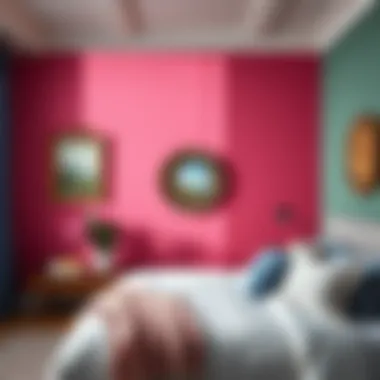
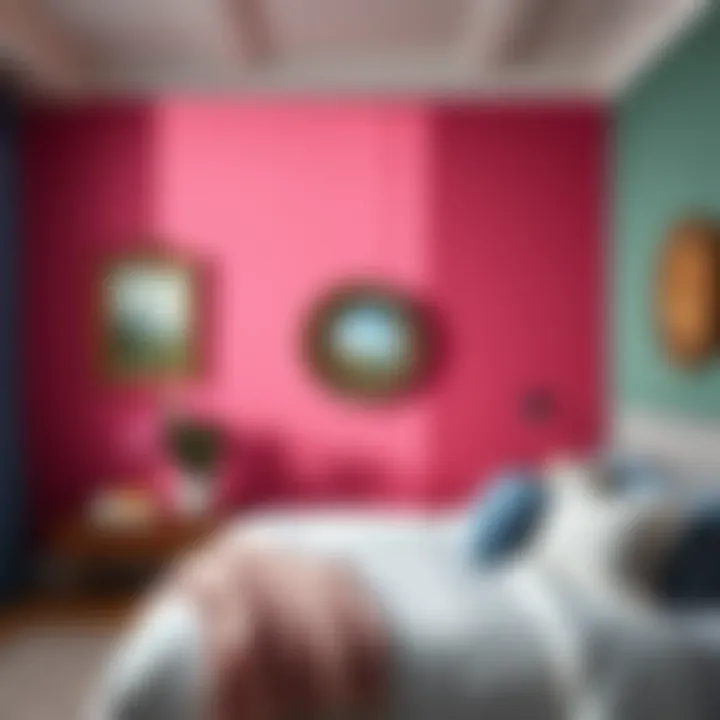
On the other end of the spectrum, you have warmer hues like terracotta and blush that are spilling over into bedroom walls. These tones can foster a sense of warmth and familiarity, inviting comfort. They tread the line between neutral and inviting, proving ideal for those looking to maintain a cozy environment while also experimenting with color.
Top Trending Colors
- Sea Salt: A calming green that promotes relaxation.
- Anew Gray: A versatile gray that pairs well with many other colors.
- Blush Pink: A refreshing take that softens the room's edges.
- Fired Brick: A warm terracotta that invites coziness.
Timeless Classics
No matter how the trends sway, some colors never lose their charm. This section highlights the reliance on timeless classics like soft whites, deep blues, and muted grays. Sherwin Williams offers a variety of shades that stand the test of time, staying relevant and stylish across generations.
For instance, "Alabaster" is a widely appreciated choice. It encompasses versatility and warmth, making it perfect for any bedroom style. You can't go wrong with a classic navy blue either, such as "Naval," which brings a sense of depth and sophistication.
When you choose these timeless colors, you're investing in a decor style that won’t easily become stale or outdated. These enduring shades allow you to play with accent colors in decor and furnishings, ultimately providing a sophisticated backdrop that won’t overpower the space.
Timeless Classics to Consider
- Alabaster: A warm white that creates a cozy feeling.
- Naval: A classic deep blue that adds richness.
- Repose Gray: A soft gray that blends seamlessly with most color schemes.
- Pure White: Clean and fresh, ideal for a bright atmosphere.
Bold and Statement Colors
For the more adventurous souls, there are bold colors that confidently make a statement. Sherwin Williams has a selection of vibrant hues that can electrify your bedroom and ignite passion or creativity. Think deep reds or striking yellows.
"Cavern Clay" is one such color that brings a warm, earthy feel while being bold. This unique shade exudes a comfortable vibe while making your space feel eclectic and vibrant, perfect for a room that expresses personality.
Incorporating bold colors also invites the opportunity for new design possibilities, especially as they contrast with softer furnishings or decor. They can act as a conversation starter or a feature point in the room, giving the space a personality that reflects you.
Bold and Statement Colors
- Cavern Clay: An earthy, warm tone that stands out.
- Tricorn Black: A powerful black that adds drama.
- Horizon: A bold teal that shakes things up.
- Daffodil: A bright yellow that invites cheerfulness.
Whether you select trending shades, timeless classics, or eye-catching hues, Sherwin Williams provides an incredible selection to refine your bedroom into a personal reflection of your style and comfort.
Complementing Bedroom Decor
Creating a harmonious and inviting bedroom goes beyond just selecting a paint color. Complementing bedroom decor is crucial in ensuring that every element in the room—furniture, accents, textiles—works together to craft a cohesive aesthetic. When your paint color and decor are in sync, the space appears thoughtfully curated, making a lasting impression on anyone who steps inside.
Matching Furniture and Accents
Choosing paint color from Sherwin Williams isn’t merely about picking a hue; it’s about understanding how that color interacts with your furniture and decorative pieces. For instance, if you have dark wood furniture, opting for a soft, light color like Alabaster can create a striking contrast. On the other hand, rich colors like Boonie can really make light wood or white furniture pop.
- Consider finishes: When matching paint colors with furniture, it’s not just about the color itself—consider the finish too. A matte paint can bring softness to glossy furniture, and vice versa.
- Evaluate undertones: Every color has an undertone. A warm blue like Celestial may look stunning against honey-hued wood accents, while cooler tones like Dorian Gray might clash. Pay attention to these subtleties to ensure your room feels balanced.
To sum up, well-matched furniture and accents enhance the impact of your paint choices. A room can feel inviting and comfortable when all components support one another, avoiding jarring contrasts that might distract or disturb the overall vibe.
Coordinating Textiles
Textiles are where your personal style shines through. From curtains to bed linens, these elements help soften hard lines and introduce texture. Matching textiles with your wall color can pull a room together beautifully, while carefully chosen contrasting hues can add interest and depth.
- Balance with neutrals: If your walls are bold, neutral textiles can help strike a balance. A calming white or soft gray fabric complements the drama of a deep blue wall, giving the eye a place to rest.
- Layering colors: Conversely, you can create a dynamic space by layering coordinating colors. Pairing shades of the same color family, like different tones of green or blue, leads to a versatile look that feels polished.
"The right combination of paint, furniture, and textiles can transform your bedroom from merely functional to truly enchanting."
Choosing textiles that coordinate with your Sherwin Williams paint color enhances not only the visual appeal but also the tactile experience of your bedroom. Each soft throw or patterned pillow adds to an atmosphere that reflects your identity, ultimately creating your personal sanctuary.
Choosing the Right Finish
Choosing the right finish for your bedroom paint is vital. It can transform the overall look and feel of your space. A finish isn't merely a matter of aesthetics; it contributes to the durability and maintainability of your walls. Different finishes reflect light in unique ways, creating subtle variations in color intensity. This means that a well-chosen finish can enhance the emotional vibe of the bedroom, making it inviting or energizing, depending on individual preference.
When considering finishes, it's essential to think about the room's lighting, the kinds of activities that will take place in the space, and the overall style you want to achieve. For instance, a high-gloss finish might seem attractive, but is it practical for a bedroom where you want relaxation and comfort? The finish also plays an essential role in how easy it is to clean and maintain your walls over time. Considering these aspects will lead to a more satisfying end result.
Matte vs. Satin vs. Gloss
Understanding the differences between matte, satin, and gloss finishes provides a better grasp of how each can affect your bedroom.
- Matte Finish: This option has a non-reflective surface that absorbs light. It's great for hiding imperfections in the walls, giving a smooth and sophisticated look. One downside is that it’s harder to clean, which might not be ideal for high-trafficked areas.
- Satin Finish: Striking a balance between matte and gloss, satin offers a subtle sheen. It's easier to clean than matte, making it a practical choice for areas like bedrooms. The finish reflects light enough to brighten a room without being overly shiny.
- Gloss Finish: This finish is highly reflective, giving a polished look. Although it adds vibrancy to colors, it generally highlights surface imperfections. Gloss finishes are usually recommended for trim and moldings rather than large wall areas in bedrooms.
Depending on your needs, you may prefer one finish over another. Knowing what each finish brings to the table can help you make a more informed decision.
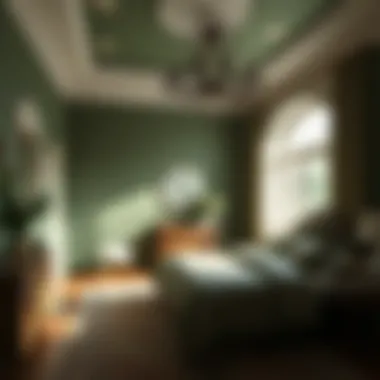
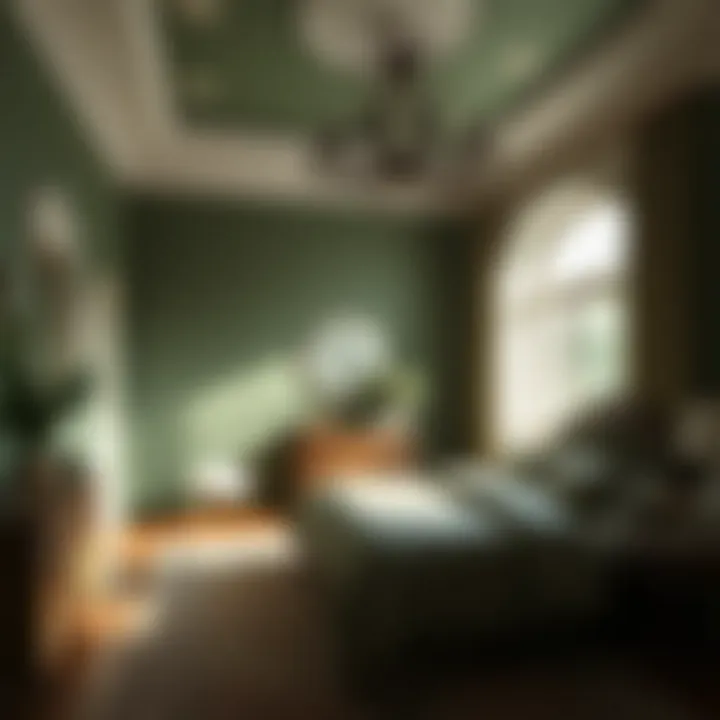
Durability Considerations
Durability is another critical aspect to ponder when selecting a paint finish for your bedroom. The lifespan of painted walls can vary significantly based on the type of finish you choose. Here are some key points to keep in mind:
- Longevity: Gloss finishes often outlast mattes. Their resistance to moisture and dirt makes them suitable for long-term use, especially in a bedroom setting where you might want to update or touch up walls less frequently.
- Maintenance and Cleaning: Satin and gloss finishes are much easier to wipe down, making them more forgiving of scuffs and stains. For families or individuals prone to spills, these may be your best bet.
- Impact of Wear and Tear: High-traffic areas or homes with pets might benefit from more durable finishes. In contrast, if the bedroom is more about serenity and less about bustling activity, a matte finish could serve beautifully.
Investing time in evaluating these durability considerations will ultimately yield a bedroom that stands the test of time while reflecting personal taste and lifestyle.
Choosing the right finish is not just about how it looks; it’s about creating a space that lasts and feels like home.
For more information on paints and finishes, visit Sherwin-Williams or check out resources on painting techniques on Wikipedia.
Lighting Considerations
Lighting plays a crucial role in how we perceive color within a space, particularly in the bedroom, where we seek a balance of comfort and style. The effect of light on paint colors can transform the ambiance, altering mood and depth. As you choose your palette from Sherwin Williams, consider the lighting conditions your bedroom will experience throughout the day and how they can enhance or detract from your chosen shades.
Understanding these dynamics empowers homeowners to create a more cohesive environment, where the colors resonate with the light, promoting tranquility.
Natural Light and Its Impact
Natural light is perhaps the most significant factor affecting paint color perception. The direction and intensity of sunlight entering a room can change how we experience color at different times of the day.
Key effects to keep in mind:
- Warmth vs. Coolness: South and west-facing rooms capture more warmth, which means colors may appear richer and deeper. On the other hand, north-facing rooms generally receive cooler light, making colors like blues and greens appear even cooler or more subdued.
- Time of Day: A color that seems serene in bright daylight may appear darker or even gloomy at dusk. It’s wise to observe how prospective paints react to the shifting light throughout the day.
- Window Treatments: Curtains or blinds can modify the influx of light. If you plan to use sheer textiles, lighter colors may appear even softer, whereas heavier materials could absorb light, making the room feel cozier.
In summary, when selecting paint, don’t just imagine it in isolation; consider the natural light's daily dance in your bedroom space. Test swatches in various corners and at different times to ensure satisfaction.
Artificial Lighting Effects
While natural light showcases the beautiful nuances of colors, artificial lighting also contributes significantly to how colors are perceived in the bedroom. This aspect is often overlooked but is equally vital in the color selection process.
Types of artificial lighting to consider:
- Incandescent Bulbs: These emit a warm, yellow glow, enhancing yellows and warm colors. If your bedroom features reds, tans, and soft pastels, these bulbs will provide a welcoming glow.
- Fluorescent Lighting: Generally cooler than incandescent, these lights may cast a blue hue, sometimes washing out warm colors. They’re best used in craft or utility spaces, rather than intimate bedroom settings.
- LEDs: Versatile and available in various color temperatures, LED lights can mimic the effect of natural daylights. Choosing adjustable LED bulbs allows flexibility in the bedroom environment, all while saving energy.
Incorporating multiple layers of light—like a bedside lamp, overhead chandelier, and perhaps some ambient LED strip lights—will create depth in the coloration of your walls. Aim for an interplay of lights; this multi-layer approach offers versatility and enhances the overall aesthetic.
Innovative Techniques for Applying Paint
When it comes to transforming a bedroom, the right paint technique can make all the difference. Exploring innovative methods for applying paint not only enhances aesthetics but also adds a layer of personality to your sanctuary. Sherwin Williams provides a wide palette, but how one chooses to apply that paint can create depth, texture, and striking visual interest. It’s important to consider these methods, as they allow homeowners to infuse their spaces with creativity while maximizing the visual impact of their chosen colors.
Two-Tone Walls
Two-tone walls are a brilliant way to bring a dash of creativity to your bedroom. This technique allows you to utilize two distinct colors, usually by dividing the wall into two sections. It’s often accomplished by painting one color on the lower half of the wall and the other on the upper half, separated by a horizontal line.
This not only adds a modern touch but can also create an illusion of height or spaciousness in a room. For instance, pairing a soft beige on the bottom with a dusty blue on top can offer a grounded yet airy feeling.
Considerations include:
- Color Coordination: Ensure that the hues complement each other, leaning towards analogous colors for harmony.
- Height Matters: In a room with lower ceilings, a lighter shade on top can make the space feel taller.
- Visual Balance: It’s crucial to achieve equilibrium by using accessories that tie both colors together subtly.
“A little bit of creativity can take your walls from drab to fab.”
Accent Walls
Accent walls serve as a focal point within a room and can dramatically shift the ambiance. Utilizing a striking color or even a patterned design on just one wall allows the other walls to serve as a canvas, enhancing the beauty of the accent. Sherwin Williams has a plethora of options for accent walls, from deep hues that evoke warmth to lighter shades that reflect tranquility.
Choosing the right wall for the accent is key. Typically, the wall behind the bed or a standout architectural feature works best. Some popular choices include:
- Rich Colors: Such as dark gray or forest green that create a cozy, inviting atmosphere.
- Graphic Prints: Wallpaper or stencils can be employed for a bolder approach.
- Textures: Incorporating wood paneling or even fabric can seamlessly blend to enhance the overall theme.
Therefore, don’t hesitate to add a splash of vibrancy with an accent wall, ensuring it echoes a part of your home’s character.
Stripes and Patterns

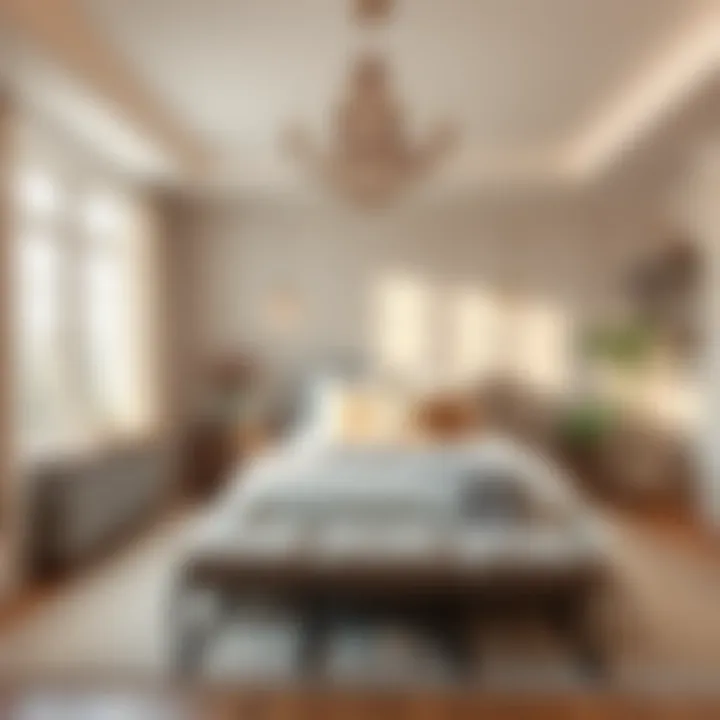
Stripes and patterns provide an interesting twist to conventional paint jobs. Employing stripes on walls can either visually enlarge the space or add a playful element, depending on the orientation and style. Horizontal stripes can create a wider appearance, while vertical stripes can give the illusion of height.
You might consider:
- Contrasting Colors: Using two contrasting colors can significantly elevate the visual interest. For example, soft pastels can yield a pleasant, sophisticated look, whereas bold colors can wake up the room.
- Thin vs. Thick Stripes: Thin pinstripes can add subtlety, while wide stripes tend to command more attention.
- Patterns: Beyond stripes, think polka dots or chevrons can add an element of fun if executed thoughtfully.
The technique requires precision, making it essential to measure accurately and tape edges carefully for clean lines.
Overall, these innovative techniques when applied thoughtfully can significantly enhance the bedroom's overall atmosphere and reflect the homeowner's unique style. Exploring such methods with Sherwin Williams colors gives a palette of options, ensuring the end result is nothing short of spectacular.
Creating a Cohesive Look
When one thinks about the bedroom as a personal sanctuary, the importance of creating a cohesive look can't be overstated. A harmonious environment isn't just visually pleasing, but it also encourages a sense of peace and relaxation. When color flows smoothly from one area to another, it brings unity and purpose to the spaces we inhabit. Especially within a home, there is an intrinsic relationship between rooms, and maintaining a consistent color palette can create a seamless transition that feels pleasing to the eye.
Color Flow Between Rooms
Incorporating color flow between rooms is vital to maintaining harmony in your home. This doesn’t mean every room should be painted the same color, but rather that there should be a strategic choice of shades that relate to one another.
- Establish a Base Color: Choose a base color that can be echoed in various shades throughout the home. For instance, if a soft blue is chosen for the bedroom, a pale version of this blue can be used in the adjacent hallway, providing a gentle transition.
- Use Transition Colors: You can create connections through the use of transitional colors in adjoining spaces. If your bedroom is painted in a warm beige, consider a deeper, earthy tone for the living room that complements the beige instead of contrasting wildly.
- Limit Your Palette: Stick to a handful of colors that will represent your overall decor. This reduces the chaos often seen in homes with wildly different, clashing colors and establishes a calming flow.
"A consistently chosen color palette can serve not only to beautify but also to simplify our choices in decor."
Transitional Spaces
It's important to recognize the transitional spaces within your home. Hallways, entryways, and even staircases are these bridge areas. They often aren't given the same attention as main rooms, but they play a crucial role in color transition.
- Coordination Over Contrast: Rather than using bright, contrasting colors that can jar the senses, consider soft hues that lead into the next room. This can be especially effective in hallways that connect multiple rooms. A light gray in the hallway can smoothly transition into a deeper gray or a playful blue in an adjacent bedroom.
- Ceiling and Trim: Sometimes it’s best to use color on the ceiling or trim to create a sense of cohesion. You might paint the ceiling in a pale version of the bedroom's wall color to unify the entire space visually. Likewise, using the same trim color throughout can help to link various areas together.
- Purposeful Lighting: If transitional spaces are well lit, it opens possibilities for color. By using natural light to your advantage, you can make colors appear softer and more inviting, providing a welcoming flow from space to space.
Creating a cohesive look in your home may seem like a daunting task, but with thoughtful planning and a clear vision, anyone can breathe new life into their living spaces. Remember, the colors you choose will define not just the look of your interior, but also the overall feel of your daily environment.
Personalizing Your Space
Personalizing your bedroom is an essential aspect of creating a space that truly feels like home. While color choice plays a vital role, personalizing goes beyond mere aesthetics. It reflects personal taste, cultivates comfort, and fosters a sense of belonging. A bedroom is your personal sanctuary, where you unwind after a long day; hence, it should express who you are and what makes you feel at peace.
When you think about personalizing your space, consider the elements that resonate with you. Are there specific colors that evoke fond memories or feelings of joy? For example, a deep navy blue might remind you of a favorite vacation by the sea, while a soft lavender might reflect cherished moments spent in a tranquil garden. Embracing such connections can transform even the simplest of rooms into a deeply meaningful space.
Incorporating Personal Taste
Incorporating personal taste into your bedroom design is about curating a palette that resonates with you. Every individual has unique preferences, often shaped by experiences, culture, and style. When looking to paint your bedroom, it might help to start by identifying colors that speak to you personally.
Ask yourself questions such as:
- What colors make me feel calm and relaxed?
- Which shades do I find invigorating or energizing?
- Are there any hues that I've always been drawn to, but shy away from?
You could also explore color swatches from Sherwin Williams and gather paint samples. This hands-on approach may illuminate your favorites, making the selection feel more intuitive rather than a daunting task.
In addition to colors, consider integrating artwork, textiles, and furnishings that reveal your preferences. A vibrant abstract painting or family photographs framed with care can enhance the essence of who you are. Throw pillows and blankets in uniquely patterned fabrics can also provide comfort while showcasing your personal style. Adding these elements rounds out the space, blending color choices with tactile and visual diversity.
Reflecting Identity Through Color
Color isn't just a mere aesthetic choice—it's a reflection of identity. When selecting the hues for your bedroom walls, think about what color conveys your sense of self. For instance, if you find strength in earth tones, a rich sage green or warm terracotta might suit your needs, fostering a sense of stability and security.
"Colors, like features, follow the changes of the emotions." - Pablo Picasso
Reflecting your identity through color can manifest in subtle ways. A pale blue may express tranquility, while a bold red could symbolize passion and vitality. Consider how colors correlate to your personality traits. Do you prefer classic, understated tones or vivid, attention-grabbing shades?
Additionally, cultural influences can play a significant role. Many cultures attribute different meanings to colors, which might further inform your choices. For example, white symbolizes purity in some cultures, whereas in others, it may represent mourning. Understanding these nuances invites a deeper appreciation of how your space communicates who you are.
In summary, personalizing your bedroom is an enriching journey. It requires thoughtfulness, reflection, and a willingness to explore how color and decor choices reveal your identity. Sherwin Williams offers an impressive range of colors that cater to different motivations and inspirations. The goal is to create a bedroom that isn’t just visually pleasing but resonates with you on a personal level, ensuring it truly feels like a sanctuary.
Epilogue
As we wrap up this exploration of bedroom paint color ideas from Sherwin Williams, it becomes clear that the colors we choose hold tremendous importance in shaping our personal sanctuary. These hues do more than just beautify a space; they emotionally connect us to the environment we inhabit. A well-thought-out color scheme can set a calming atmosphere or invigorate creativity, effectively transforming your bedroom into a haven that aligns with your own image.
Recap of Key Ideas
Throughout this article, we’ve discussed various aspects of selecting paint colors that suit your bedroom. Here’s a quick rundown of the important points:
- Understanding Color Psychology: Colors evoke feelings such as calmness and energy, influencing our mood and well-being.
- Sherwin Williams Color Palettes: From trending colors to timeless classics and bold choices, there’s a palette for every personality.
- Complementing Decor: Matching paint with furniture and textiles ensures harmony in design.
- Finish Matters: The choice between matte, satin, or gloss affects not only aesthetics but also durability.
- Lighting's Role: Both natural and artificial light can alter how colors appear, making it crucial to consider light sources in your selection process.
- Unique Techniques: Innovative paint applications like two-tone walls and accent colors can add depth and character to your space.
- Personalization: Selecting colors that resonate with your personal style can create a deeply expressive environment.
Final Thoughts on Sherwin Williams Colors
In the end, the journey of picking the right paint colors goes beyond mere selection; it’s about reflecting who you are and how you want to feel in your space. Sherwin Williams offers a spectrum of options that cater to diverse tastes and needs. The insights gathered here should empower you to make informed choices, ensuring your bedroom is not just a place for rest, but a reflection of your unique self. Whether you aim for tranquility with soft neutrals or prefer energetic shades, the right paint can seamlessly blend functionality with style. Making your bedroom a true retreat is entirely achievable with the right color palette and application techniques. Embrace the freedom to express yourself through color, making your sleeping space as vibrant or serene as your heart desires.



